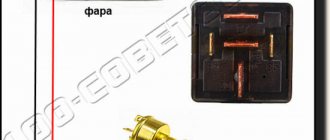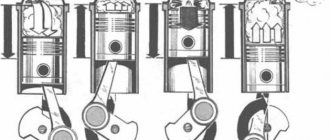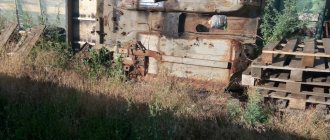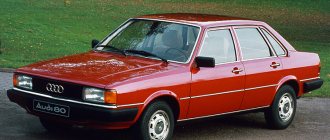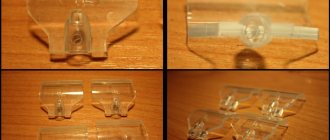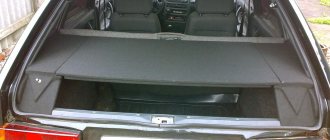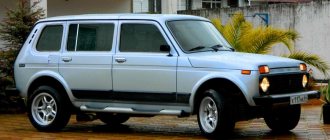Design features
Audi 80 B3 and B4 are theoretically the same car, but with some technical differences. The B4 received a modified platform with a wheelbase increased by 70 mm. The fuel tank was located under the floor, and not as in B3 - behind the sofa. The transformation made it possible to build a station wagon version of the Avant. Previously, only the sedan and coupe were available. It is worth noting that the B3 sedan has a more spacious trunk than the B4 sedan - 453 liters versus 430.
The design of the Audi 80 is very simple, so the car is very reliable. A galvanized body is not prone to corrosion, unless it was hastily repaired in some garage.
Despite the lack of airbags, the car is quite safe. All thanks to the unique Procon-Ten design. In the event of a frontal collision, the engine, through a system of cables, retracts the steering wheel and additionally tightens the seat belts. This significantly reduces the risk of hitting your head on the steering wheel. The steering wheel airbag only appeared in 1993.
The car is front-wheel drive, although it has a longitudinally mounted engine. The suspension design is simple. The front has MacPherson struts and the rear has a torsion beam. The settings provide a high level of comfort and controllability. The ride quality is impressive.
Models were also offered with Quattro all-wheel drive. This is a standard design with a differential and constant distribution of traction along the axles. The system significantly improves traction and handling – the Audi 80 B 4 runs as if on rails. True, the all-wheel drive transmission limits trunk space - the floor is located higher. The Quattro prefix could only be received by modifications with 2.0-2.8 liter gasoline engines.
compatibility of Audi 80 and VAZ — Audi 80, 1.8 l., 1988 on DRIVE2
the recording is not mine. came across while climbing through the expanses of the drive. I decided to copy it for myself - what if it comes in handy? Here is a list of some parts that are identical, or very similar to the parts of our Soviet cars. 1. External CV boot is identical to the boot of the VAZ-2108 2. gaskets (damping gasket) for the rear springs to increase ground clearance from 2108 3. rubber bands for the front suspension stabilizer from 2101 4. silent blocks of the front levers from the Audi 80 with GU (much stronger) 5. baseless light bulbs in buttons on the console and illumination of the heater control panel from the dashboard of our cars.
6. rubber bands for hanging the muffler from 2108 7. generator belt from the classic 940x10 8. valve stem seals from LADA (a unified part, also known as VW AUDi SEAT, etc.) 9. valve puller from 2108, slightly reduce the outer diameter 10. CV joint puller from 2108, bore with emery to the diameter of the drive shaft 11. The front brake pads are made, if desired, from GAZ 3110 and Moskvich 2141 pads. But you just have to cut a lot! 12. Well, there’s probably no need to talk about the fact that wipers are now universal anyway. no comment 13. Yes, the radiator and fan also fit from a VAZ 2108, but the price is far different. The only problem during installation is to figure out where to connect the expansion tank, because... on 2108 it is included in the thermostat, and on Audi it is included in the radiator. 16. generator from 2110 fits A100-44, tested 17. A100/44/Avant power steering, steering rack cover from M2141, tested 18. windshield wiper blades from 2110, but with mount from Audi 19. high-voltage wires - Zhiguli, from an injection engine 20. cartridges front struts from 2108 (you need to additionally cut 1cm of M14 thread) and the difference in price from one manufacturer is insignificant. Installation is not particularly recommended! 21. rear springs from 21099 (you have to tighten the diameter in a vice a little more, but over the year they have shrunk significantly) the best solution is step 2. anthers and bumpers for the front struts from 2108 (yellow bumpers SHIT) 22. lambda probe from 2110, or rather just Bosch. 23. windshield washer motor pump from 2108 24. submersible fuel pump from injection 2110 and 3110 25. 80A generator from 2110 26. rear caliper guides from 2108 27. timing belt from the classic 122 teeth 19 mm (original 121x18) WITHOUT . rear shock absorbers from 2108. 29. Regarding the Audi 80, the front brake discs fit from 2141 without problems 30. On the Audi 80, the ignition switch from the VAZ 2110 was installed, one minus is that the steering lock will not work... 31. on the A80/B3 engine. The crankcase ventilation hose from the VAZ-2109 is suitable for RM. It is trimmed on one side by 1.5 cm.
thanks for the info www.drive2.ru/cars/audi/80/80_b3/andreimordovia
www.drive2.ru
Interior
The interior seems dated today, but back in the 90s it was considered luxurious. Large steering wheel, easy to read gauges, short gear lever, comfortable seats and good workmanship. Wide-opening doors provide convenient access to the interior.
The car was well equipped. But, on the other hand, in the poor versions the equipment was primitive. Today, air conditioning is of greatest importance as the most necessary element in everyday use.
Engines
The range of Audi 80 B4 engines is quite large. The base 1.6-liter gasoline engine developed from 76 to 102 hp. Later, a modernized version of this unit found its way under the hood of the Skoda Octavia and Volkswagen Golf VI.
Much more often, cars with a 2-liter engine 2.0 and 2.0 E came out of showrooms. The engine provided from 90 to 140 hp. (in 16-valve version). In addition, the following were available: a 5-cylinder - 2.3 l (133 hp) and two V6 - 2.6 l / 150 hp. and 2.8 l/174 hp.
Almost all gasoline units were equipped with multipoint injection, mostly electronically controlled. The 5-cylinder has mechanical injection and is therefore completely unsuitable for gas power. Only the basic 1.6 and 2.0 liter versions are equipped with simple single-point injection.
An absolute new addition to the lineup is the 1.9 TDI diesel engine, which replaces the outdated 1.6 TD. The modern design with direct fuel injection made its debut in the Audi 80 B4. The turbodiesel developed 90 hp. and became famous for its durability and efficiency. At the same time, a 75-horsepower diesel engine of the same volume, marked TD, was offered. He is a typical draft horse and does not deserve attention.
Tags: audi
Comments 17
Consider also the option 100 (c4 45) with a 2.0 liter engine (101 hp) and the prices for spare parts are reasonable and comfort doesn’t break down, you can easily buy it in good condition,
you’ll bring it from Germany, it will fit you like an A6 from the 2000s)))) A 20 year old car has ridiculous customs duties.
It’s interesting how you get her out of Germany. and you still need to find it there and who will do it for 3 kopecks.
if you take it from Germany! It's hard for us to find anything worthwhile.
I tell you, take at least 80, at least 100, but with a carb. The injector there is disgusting (exactly the same on Mercedes of those years)
If the carb is made by the brain, stupidly change it to Solex from a chisel and that’s it. It costs 3000 rubles new. That's the maximum you can get. and with KE Jetronic... one dispenser with ERGD will cost at least 5K at dubious disassemblies. in stores to order used 11-17K and all this still needs to be configured by specialists. It is very difficult to return to factory performance
I partially disagree, all machines eat away the brain, it’s just that everything depends on the person. I'm already on my fifth hundred. not counting the other eleven different cars, and each one blew my mind in its own way. I saw such examples of Audi hundred with a mechanical injector that I marveled at how they even worked, but to my surprise the bitches worked. And the 1.8 engines also eat away the brain, after all, the years take their toll, There are people who drive for 10 years and do nothing and don’t worry about it. That somewhere somewhere something is crunching and so on, you have to look at the car, they are different and start from each one specifically, so think for yourself, you just need to drive different ones with different engines and which one the soul sunk in and take it.
I really don’t know what to do, in general everyone says differently, half FOR, half AGAINST)
I would recommend the same as mine. Without minced meat and with carb, 4 cylinders. I started it and drove it like that every day. Great car. Under no circumstances should you take it with K-Jetronic or KE-Jetronic, it’s a rare abomination
Don’t bother... bother with them... I had 6 pieces... different, in Kaliningrad, as you know, there were no problems with spare parts... but there was always a problem! The latest information on these devices is that my relative has a hundred parts... I went through everything after the purchase and that’s all... it was enough for 2 months... Age is a diagnosis, especially on high-tech hardware! If you change one basin to another, if it’s fundamental, then I think there’s no point in advising anything.
Well, I’ll say right away that an 80 in the body you need will definitely be fresher... And if you find a 90, then that’s absolutely wonderful!
In terms of prices for service and spare parts, it all depends on the condition in which you initially purchased the car. That is, the main amount after purchase will definitely be spent on bringing the car to normal condition. Everything else costs pennies!
If you immediately bought a good copy, or more or less a good one (like me... not me, but my barrel :), then you will have to invest at least a minimum to change all the consumables.
Definitely, finding a normal B3 barrel is problematic.
When purchasing, you should pay attention to everything at once! It’s better to take it to a service center for diagnostics... Believe me, taking a pig in a poke means hoping for luck! However, that’s what I bought, and, one might say, I was more or less lucky. Now I have brought it to excellent condition! In general, my car has a separate story... I advise you to read
You will learn something useful for yourself. And also take a look at the bulletin board, where there are accidents and where a second life is born) You will be pleasantly surprised by the price I spent on restoring the car
In general, my car has a separate story... I advise you to read it. You will learn something useful for yourself. And also look into the bulletin board, where the accident is, and where a second life is born) You will be pleasantly surprised by the price I spent on restoring the car.
In short, 80 rules! As soon as you buy it, every day you begin to love it more and more... ^^
Which engine to choose?
The market is dominated by models with a 2-liter gasoline engine, available in three versions. The 90-horsepower engine has single-point injection and a simple design. The 2.0 E version was equipped with multipoint injection and developed 115 hp. The top 16-valve variation had a return of 140 hp.
The weakest option is recommended for those who do not care about dynamics. Average fuel consumption will be 8-10 l/100 km. The 16-valve unit, although it does not cause many problems, is more expensive to repair. But it has better dynamic characteristics - 9.6 seconds to 100 km/h. But it consumes more than 12 liters.
The optimal choice is 2.0 E (115 hp). This unit was even used in the successor to the Audi A4 B5. He calmly tolerates the introduction of gas equipment. Any malfunctions are solely due to negligence. Minor defects concern the ignition system and intake system - leaks in the section between the flow meter and the manifold.
Oil leaks are a common occurrence.
At the same time, due to age, any element of the attached equipment may fail, oil leaks occur (from under the valve covers and seals), and rust attacks the exhaust system.
Exploitation
Service mechanics and car enthusiasts who have serviced front-wheel drive VAZ cars can repair the Audi 80 B3 without any problems. According to reviews, spare parts for this model can be found without problems. And both branded and third-party manufacturers. There are many cases when car enthusiasts installed spare parts from domestic cars. For example, rims from Moskvich-2141, some clutch and suspension parts from VAZ cars are suitable. So, everything is in order with the maintainability of the Audi 80 B3. Having a standard set of tools, you can do most car maintenance operations without any problems.
The doors are quite easy to disassemble, and the lighting elements can be changed independently without any problems. Owners of 80 B3 write in their reviews that repairs are simple. If someone does not do this themselves, it is simply due to lack of time or desire. It is thanks to its high-quality performance, maintainability and survivability that the Audi 80 B3 is still running on Russian roads.
Below are common problems with the Audi 80 B3:
- Steering gear;
- Problems with ventilation and heating;
- Brake malfunctions;
- Ignition system (with high mileage);
- Suspension.
Experienced technicians claim that the car does not have any obvious problems. Audi 80 B3 engines can overheat, like many German power plants. Therefore, regular maintenance and the use of high-quality fuel and lubricants are necessary. When servicing a car, you should constantly monitor not only the level, but also the purity of antifreeze. Many people wrote in their reviews that they successfully use antifreeze. However, it is better to use the antifreeze recommended by the manufacturer itself.
There is not much electrical equipment in the Audi 80 B3, and even less electronics. Therefore, you won’t need any complex devices to diagnose a car. And, in general, the electrical component is reliable and serves without failures for a very long time. A number of 80 B3 engines, as already mentioned, have a carburetor in the fuel supply system. In most cases, Keihin and Pierburg carburetors were installed. Owners often write that these units begin to “get sick” after using low-grade gasoline. Arrhythmia begins when the engine is running. The KE-Jetronic system, which is responsible for fuel injection in the Audi 80 B3, often becomes clogged with various solid particles from low-quality fuel.
As for fuel consumption, according to reviews, the picture is as follows. The cars in the hands of the population are mainly from 1987-1990 with a mileage of 150-200 thousand km.
- For 1.6-liter engines, 6-7 liters in the city and 5-6 on the highway per 100 kilometers;
- For 1.8 liter engines, 9-10 liters in the city and 7-8 on the highway per 100 kilometers.
There are few reviews on more powerful engines and diesel engines, and it is impossible to say anything definite about them.
The weakest point of the Audi 80 B3 cars is the suspension. These cars have a hard time navigating domestic roads. And, since the “barrels” come to us with a significant mileage, problems with the suspension arise quite quickly. Repairs can be done by replacing the entire suspension at once or by repairing parts separately. It is worth noting that broken parts should not be restored. This leads to disastrous consequences. Most often the repair revolves around the shock strut being removed and replaced with a new one. We also recommend reading the article about tuning the Audi 80 B3 on our website. Return to content
What else breaks?
Given the age, any element of the equipment may fail, but there are no characteristic sore spots.
The owner can afford to travel on bad roads. The suspension is designed in such a way that major repairs do not seem too expensive. Front wishbones made of steel (from 1,500 rubles) have replaceable ball joints (from 400 rubles). Some people note that the lever bushings are not very durable. The rear axle is so primitive that, in principle, there is nothing to break there.
In general, the braking system is very effective, and many examples were equipped with ABS. Trouble can be caused by the parking brake, which often turns sour. Its mechanism requires preventive inspection and cleaning.
Failures also occur in the operation of electrical equipment: lighting systems, electric windows or central locking.
Quite often, the fluid supply tubes to the windshield washer nozzles become disconnected.
Reworking the 2114 engine - reasons and difficulties
Generally speaking, replacing the motor is an undesirable procedure. The reason lies in the fact that the engine installed at the factory is the most optimal for this particular car - everything has already been thought out by the designers and engineers. True, the results obtained do not always satisfy motorists.
So, it’s worth comparing at least the total resource of domestic and foreign engines. For the first (specifically for the VAZ 2114) it is 250,000 kilometers, and for the second (similar in all other parameters) - 500,000 kilometers. Even this fact alone makes drivers think about installing an engine from a foreign car in a VAZ 2114.
When to change spark plugs on Audi 80
Spark plugs are changed in two cases:
- planned - according to odometer readings/service life;
- unscheduled - in the event of malfunctions in the ignition system associated with failure/incorrect operation of spark plugs.
The service interval for replacing spark plugs on Audi 80 vehicles is 30,000 km . However, in reality, good candles can last longer. Many motorists prefer to change spark plugs without reference to a specific mileage and do this annually - before the onset of cold weather. This approach is not without logic, since “fresh” spark plugs are guaranteed to provide much easier starting of the internal combustion engine in cold weather.
Engine dismantling process
Of course, the best option would be to replace the engine in a fully equipped workshop, but if this is not possible (and you really want to do tuning), then you should have the following minimum set of equipment:
- winch, hoist or hydraulic lift;
- shoes;
- jacks;
- cart;
- knob with a set of heads;
- spanners;
- screwdrivers.
Dismantling is carried out in the following order:
- The car is stopped using a hand brake and shoes, which should be placed under the rear wheels.
- Place the front wheels on jacks.
- With the hood open, disconnect the “mass” terminal and all small hoses and tubes suitable for the engine.
- Seal the pipe inlets to the engine to prevent them from clogging.
- Disconnect the throttle cable from the throttle pipe and bracket.
- Disconnect the air intake hose together with its bracket.
- To dismantle the air filter - to do this, use a sharp blade to cut off the three rubberized supports, due to which it is attached to the engine body.
- Remove the hoses leading to the receiver.
- Disconnect the hose intended for purging the adsorber from the nozzle.
- Remove the wires suitable for the pipe, the ignition module, as well as all others connected to the internal combustion engine.
- Remove the engine splash guard by unscrewing the mounting bolts.
- Drain all the coolant by removing the plugs on the cylinder block and radiator (while opening the reservoir cap).
- Drain the oil by unscrewing the plug cap on the gearbox.
- Disconnect the clutch cable.
- Secure the hooks of the lifting device to the eye bolts located on the gearbox and on the cylinder block, and then remove the engine.
Installation of the new motor is carried out in exactly the same order, but in reverse order. Also, it is important not to forget to connect the wires of all sensors to the correct connectors and refill all technical fluids that were drained during dismantling (coolant and oil).
Despite the fact that some car enthusiasts advise first removing the gearbox and then removing the engine, it is strongly recommended to remove the engine together with the gearbox.
Answers (8)
The four is better, it is cheaper to maintain and newer.
Four, like the entire domestic auto industry, is complete crap. Regarding spare parts and up to cans, spare parts. Cheaper than twice as much but with the same performance of 80 and 2114 on 14 in a year you will change 4 balls at the same time as on 80 1 if you take the original spare part. Now think for yourself which is cheaper. And the engine of the new 14 will not pass even 1/3 of what the 80 engines will pass!
depending on what condition they have, if for example the Audi is in very good condition, then her)
In terms of power, comfort and reliability, the Audi will of course surpass the VAZ, but here we are talking about an old Audi, so I would think about it. Therefore, you need to check both cars for malfunctions and weigh all the pros and cons. after all, repairing foreign cars is always more expensive than Russian cars
I think the fourteenth is better, the Audi is too old
a strange choice of course) these cars cannot be compared, and if you compare, then add here other foreign cars, like Golf, Opel Astra and so on
Audi, but keep in mind that any car breaks down, and for Audi the prices for spare parts are much more expensive than VAZ ones
don’t drive me... it’s not particularly expensive to maintain an Audi 80, but there aren’t any good ones... and as they say in good condition, where are they? Unless this one
Anyone who thinks that repairing a barrel is more expensive than a vase is a deer. Initially I drive a VW 2003 with a multi-link and repairs, if you count by year and mileage, are 2 times cheaper than those of the pelvic floors. For 2 weeks in June, the mileage was 8,700, for the year 2014 -132,000, 2015 -127,300, 2021 - about 76,000, as a result, each cylinder was running at 14 atmospheres as from the factory, I poured Mobile Longlife oil according to the approval for my turbo engine 1700 for 5 liters, + top-up 320 1l for mileage from replacement to replacement 15-18t.km oil filter 340 rubles MANN, fuel filter 270 rubles the same MANN, cabin filter 220 RUR (carbon), air filter 270 RUR, changed the chassis once in 3 years in 2021 in June 50 thousand rubles, and changed the brakes all around in November 15 thousand rubles. (discs, pads, abs sensors - because they are the same age as the car and the insulation has burst, caliper repair kits all around including pistons and hoses) and this is all in 15, etc. I put ATE pads enough for 20-25 t.km. Front pads with wear sensors 620 rubles, rear without sensors 340 rubles, oh yes I forgot the front wheel bearing, 2 pieces for 720 rubles. and I’ve already driven 30,000 on them, and the heater radiator is 716 rubles, the car, ideally, will now go on for hundreds of thousands of kilometers, and those who will yell like not all the spare parts are original, keep jerking off to your VAZ originals))) fuck... I have such original quality when, while picking up a VAZ from Togliatti, the hub falls off while driving, there is no market for Vesta or Priora standards, but it’s better oh…. comfort and safety + power than new shit with no noise, metal from cans and a bunch of sores that also need to be eliminated like in an old foreign car, I’m not even talking about old vases if the new ones have jambs, but it’s better to take a galvanized body, whole and strong than to watch your vase bloom all over in a year, in those places where the previous owner hid it. Oh yes, I completely forgot the new Priora in the top + Shumka + rollers with tires and music, the neighbor took it for 500k+, I paid for 320k Passat + 3 years of driving without repairs, not counting consumables + 50 tr. chassis + 15 tr. brakes + wheel bearings we’ll give 1.5 t.r. and 700 rubles for the heater, I do everything myself because it’s even easier than in TAZ, well, only after replacing the levers, the camber costs 1,200 rubles at the service station, and it still comes out cheaper than Priors + metal in the base 1.5 mm, rear double metal fenders, side members 6mm pipe 80X100 at the rear and 100X100 at the front, sill reinforcements 6 mm, sills 2 mm, Shumka thickness 7cm + bottom filled with rubber from the interior side + all this is galvanized completely body on both sides I checked it myself scratched the roof from the inside + heavy doors that are sealed and glued with Shumka from the factory, whoever has seen them will understand that they are sealed in plan, not with holes under the casing like a vase, but closed with a steel plate to which the window lifter and door trim with Shumka are attached + soft panel and all the interior details, leather interior, Shumka everywhere. absolutely everywhere, even under the roof lining and in the trunk! + 16 inch wheels in stock + excellent music from the factory speakers with the VAG label 13 years old and not a single one that is not working + built-in amplifier and the whole thing works so you don’t need a sub, oh and also + athermal greenish tinting of all windows from the factory and as a result later 3 years and x... a ton of mileage for them, ideally I have a C class car (with 8 airbags), cheaper than the neighbor's Priora, which turned into rusty metal because it drove about the same amount))) taxis on it))) So To all the pelvis manufacturers, a big bolt and smaller calluses, masturbate and continue to masturbate your pride with new cars, and somehow I’ll drive the old “Junk” with comfort and safety.
Which imported engine should you prefer?
Now let's move on to the main question - what engine can be installed on the VAZ 2114? Answering this question, I would like to remind you once again - you should choose only the one that can be installed without modifications or with a minimum number of them.
These imported engines include engines from:
- AUDI-80;
- BYD F3;
- Alfa Romeo;
- Chery Amulet;
- Chevrolet Aveo;
- Ford Focus;
- Fiat Bravo;
- Geely CK2;
- Geely MK1;
- Honda Civic;
- Daewoo Lanos;
- Opel Astra;
- Hyundai Accent;
- Opel Corsa;
- Opel Astra Kadett;
- Opel Astra Vectra B;
- Seat Ibiza;
- Mazda 323;
- Mazda 626;
- Peugeot 205;
- Peugeot 405;
- Toyota Supra;
- Renault Logan;
- Volkswagen Golf;
- Volkswagen Jetta.
All of the listed engines can be installed on the 14th VAZ with a minimum of alterations to other mechanisms, in most cases - without any alterations at all. This will help save not only effort and money for additional work on replacing units, but can also save a lot of nerves when registering a car with the road inspection (although registering such a tuned car will still be a very big problem).
That is why, before deciding which engine is suitable for a VAZ 2114 from a foreign car, it is better to think again about tuning an existing, original engine. There are quite a few ways to increase its power and service life without replacing it with another, and all of them are completely legal from the point of view of the law.
What is better Lada Priora or Daewoo Nexia?
What is better - the updated Lada Priora or the long-familiar Daewoo Nexia? The question is not easy, since both cars have a lot in common, but there are also enough differences between them. To find the answer, let's compare sedans according to the main criteria.
So, Priora or Nexia, which is better? Let's start with the fact that Nexia is, without a doubt, one of those vehicles on the Russian market to which AvtoVAZ’s “brainchildren” can seriously compete in terms of design. Nexia in its current guise has been rolling off the assembly line since 2008 and has not been subject to particularly deep modernization in the intervening time, which cannot be said about Priora. She is a year older, but has already undergone a number of significant restylings, the last one being quite recent. This is a small advantage of a domestic car: if you are interested in a more modern appearance, then Nexia immediately disappears.
Regarding the interior, the Lada also looks more attractive - again thanks to the update, which raised the car’s interior to a different level, so the Daewoo Nexia, with creaking budget plastic and not the highest quality fabric on not very comfortable seats, is significantly inferior in the “interior” competition. In this regard, Lada offers a pleasant high-quality finish, good ergonomics of the dashboard, comfortable seats and an optimal amount of free space above the head and legs - more than in the “Uzbek” favorite.
When answering the question: which is better than the Daewoo Nexia or Lada Priora, do not forget about the trunk capacity, and here Nexia wins: 530-liter compartment versus 430-liter for the Priora. But, at the same time, the opening for loading in the Daewoo is narrow, and besides, the rear seat backs do not fold, and therefore you cannot squeeze in more or less oversized cargo.
If you have not yet decided which is better than Priora or Daewoo Nexia, pay attention to the technical stuffing. VAZ auto offers a trio of 1.6-liter engines producing 87, 98 and 106 “horses”
The South Korean product hides only two engines under the hood: an 80-horsepower 1.5-liter and a 106-horsepower 1.6-liter
The younger Daewoo engine does not deserve special attention: the torque is weak (123 Nm), the fuel consumption is huge (about 8.1 liters), and it behaves poorly in winter. But there is one advantage - indiscriminateness in “food”: you can fill in both 80th and 92nd
Taking into account the above, there is no doubt that the Lada Priora or Daewoo Nexia is better, since even the 87-horsepower Lada engine looks like a beast here: 140 newton-meters of thrust and only 7.3 liters of gasoline consumption. What can we say about the older engine - it is simply a favorite, although in terms of dynamism and traction it is comparable to the 106-horsepower “foreign” competitor. In terms of efficiency, Nexia is again noticeably behind: Priora, on average, is content with about 8.9 liters versus the “Uzbek” 8.9.
The gearbox of both cars is similar: a 5-speed manual, but the Lada’s gear shifts more easily and smoothly. The Priora's higher ground clearance (165 mm versus 158 mm) is, of course, preferable for domestic roads.
Before making a final conclusion about which is better than the Daewoo Nexia or Priora, let’s look at another important factor - cost. The lower price level of the Daewoo Nexia - however, like the upper one - is significantly lower than that of the Lada Priora
Whether this is an advantage or a disadvantage of the “Uzbek” is up to you to decide.
Now let’s sum it up and try, nevertheless, to decide: which is better, Nexia or Priora? It is, of course, up to the buyer to choose, but it seems to us that this is the very case that will disappoint domestic fans of foreign cars, who believe that the latter are much better than representatives of the Russian automobile industry. Undoubtedly, “our” Lada Priora is in many ways superior to the South Korean car, with all its “foreign” tempting.
By the way, in 2021, the Uzbeks began to gradually replace the Daewoo Nexia on the assembly line with a new budget car under the Ravon brand, the model range of which also includes Nexia. But this is a completely different car - a modified Chevrolet Aveo and a completely different story...
What to choose: AUDI 80 B3 or VW Passat B3?
AUDI 80 B3 and VW Passat B3 are two of the most popular and best-selling cars at the Grodno Car Market.
We compared the 1988 VW Passat B3 with a 1.8 petrol engine (carburetor) and the 1988 AUDI 80 B3 with a similar engine.
The class of these cars is the same. The price of AUDI is on average 200 cu higher. As of March 2007, the price of AUDI is about 3000 euros, and VW is 2850 euros. (88 year, 1.8 gasoline). None of the cars have additional options. And even such familiar things as power steering or central locking are very rare.
Audi 80
Today I decided to fix the well-known problem of Kalina 2 - the front parts of the sills peeling off due to short mudguards. Since I was one of the first to buy Kalina 2, I didn’t know about this jamb, and when I found out it was too late. So I drove for 4 years with bare metal
. During this time, a little rust appeared on the zinc - the zinc also began to sandblast. Today I covered the bare metal with two thick layers of anti-gravel, three thick layers of paint and three thick layers of varnish. If this turns out to be sufficient, I will not change the mudguards.
At the same time, the guys in the neighboring garage were priming the Audi 80 - the entire body. Before that, they also galvanized it! The car was produced in 1987, was in an accident, and the entire left side was replaced. Actually, this is a clear example of why some old foreign cars drive in good-looking condition.
One of them started telling me how beautiful this Audi 80 is, that it will outlive my Kalina, that the thresholds of the new
Viburnums rot in two years. My objections are that I have been with 4 years
shabby
I drove through the thresholds and nothing rotted because the double-sided hot-dip galvanization on the thresholds did not affect them. They didn’t believe that Kalina was galvanized! I showed them a photo of galvanizing (by that time I had already painted everything) - it only worked on one of them.
Seeing galvanization in a photo and saying that it’s not there - I’ve never seen anything like this before!
I have nothing against the Audi 80; as you know, it served as the ideological prototype for the 2110. But you need to understand that technically its body is complete shit and was shit even at the time of its creation, despite the beautiful design.
They say that the cans have poor safety:
But they forget that 2109 weighs a little more than 900 kg versus 1100-1300 kg for the same Focus. And that by the standards of the 80s, 2109 had excellent safety. If we compare safety, then it’s with the 2109’s peers, for example, with the Audi 80.
This is 2109:
And this is Audi:
From this angle you can see the difference better:
Inogovna fans claim that the USSR lagged behind in the automotive industry, that the 2110 is just a pitiful imitation of the Audi 80. Let's compare!
This is 2110:
And this is Audi:
Especially for those who doubt that this is a photo of the same accident:
Maybe this is an accident? Got a rotten Audi against a reinforced pelvis? Firstly, Audi is not rotting according to fans of this brand! Secondly, this is a pattern!
This is 2111:
And this is Audi:
And Audi really doesn’t rot! Especially for those who doubt that this is the same accident:
We see that there is nothing to catch against the 2110 and that technically the 2110 body is head and shoulders above the Audi 80 body.
I suspect that fans of the brand will be upset by the safety of the Audi 80 in comparison with its contemporary 2109. Maybe the heavier older Audi models will be able to withstand the Nine?
Let's look with hope:
Which, alas, did not come true:
The Audi barge turned out to be less durable than the 900-kilogram 2109! The Audi driver was lucky that he didn’t end up in a kangaroo!
Fans of the brand think that if old Audis have a long hood, this means high safety. Indeed, this increases the security... of the opponent:
Let's compare the safety of the Audi 80 with the Korean-Ukrainian car - Lanos.
This is Lanos:
And this is Audi:
Unfortunately, there are no photos of these cars together.
There is nothing to catch at all against modern Audi 80 cars:
I just want to say that she’s rotten, don’t I? But Audi doesn't rot
!
The results of real Audi 80 accidents will not surprise those who have a head on their shoulders. Just look at the power structure of the Audi 80 body to understand that this is the technical level of Gas-24, i.e., the level of the 60s:
Although no, the Volga is cooler - it at least has a normal interior cage and wing reinforcement:
And in comparison with 2109 Volga is much safer:
By the way, the Volga passes crash tests better than the Audi 80.
Why didn’t anyone say in the 80s that Audi was 20 years behind the global auto industry?! How was it possible in the 80s to produce cars that were worse in safety than Soviet cars developed in the 60s? Despite the fact that Audi cars were positioned in the Volga class!
Even the 1997 Audi A4 performs better than its peer 2110 in crash tests:
Foreign cars of the 80s in terms of safety were a la Cherry Amulet which, by the way, is on the same platform as the Audi 80. Even at 55 km/h and 50% overlap, the results were simply terrible - worse than Zhiguli, which had worse safety than other Soviet cars. Zhiguli is a reinforced
licensed foreign car. The original Fiat 124 had a collapsed roof after 5,000 km of driving on Soviet roads; what would have happened in a crash test is anyone's guess.
Autoreview conducted a crash test of 2109 using the same old method, and the Nine was not new, but with a mileage of 70 thousand km:
Maybe there is a hidden meaning in the galvanization of the Audi 80 body?
author: Vitaly Kalendarev
PS
Are you still a fan of old Audis? Then we go to you!
P.P.S.
Those guys said that not only Kalina is shit, but they also remembered the UAZ Patriot - you see, it rots if you don’t paint it. It's an old Audi!
Link to post:
https://clck.ru/EMd3S
Share this Share post
- Tumblr
Liked this:
Like
